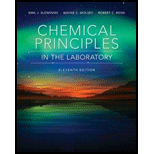
Concept explainers
To find the mass of a mole of an element, one looks up the atomic mass of the element in a table of atomic masses (see Appendix III or the Periodic Table). The molar mass of an element is simply the mass in grams of that element that is numerically equal to its atomic mass. For a compound substance, the molar mass is equal to the mass in grams that is numerically equal to the sum of the atomic masses in the formula of the substance. Find the molar mass of
Interpretation:
The molar masses of
Concept introduction:
The molar mass of a substance is equal to the mass of one mole of that substance. One mole of a substance contains
Answer to Problem 1ASA
The molar masses of
Explanation of Solution
The molar mass of a substance has the same numerical value as its atomic or molecular but different unit. The molar mass is expressed in
The atomic mass of copper
The atomic mass of chlorine
The atomic mass of hydrogen
The atomic mass of oxygen
The molar mass of
Substitute the values of molar masses of
Therefore, the molar mass of
The molar masses of
Want to see more full solutions like this?
Chapter 4 Solutions
Chemical Principles in the Laboratory
- Express the composition of each of the following compounds as the mass percents of its elements. a. formaldehyde, CH2O b. glucose, C6H12O6 c. acetic acid, HC2H3O2arrow_forward1. Which of the following hydrocarbons has the highest mass percentage of carbon? methane, CH4 ethane, C2H6 propane, C3H8 butane, C4H10arrow_forwardYou have a pure sample of apholate, C12H24N9P3, a highly effective commercial insecticide. Calculate the molar mass of apholate. Calculate the mass of N in 100. g apholate. A sample containing 250.0 mg apholate is sprayed on an agricultural field. Calculate the mass of phosphorus in this sample of apholate; express your result in grams. Calculate the number of phosphorus atoms in this sample of apholate.arrow_forward
- Calculate the mass percent of each element in the following compounds: (a) PbS, lead(I1) sulfide, galena (b) C3H8, propane (c) C10H14O, carvone, found in caraway seed oilarrow_forwardA compound associated with the odor of garlic on a persons breath has the chemical formula CyH8S and a formula mass of 88.19 amu. What number does y stand for in the chemical formula of the compound?arrow_forwardFor each of the following ionic substances, calculate the percentage of the overall molar mass of the compound that is represented by the negative ions in the substance. l type='a'> ammonium sulfide calcium chloride barium oxide nickel(II) sulfatearrow_forward
- How many moles of specified particles are present in a sample of each of the following substances if each sample weighs 7.00 g? a. N2O molecules b. NO2 molecules c. P4O10 molecules d. V atomsarrow_forward3.123 Most periodic tables provide molar masses with four or five significant figures for the elements. How accurately would you have to measure the mass of a sample of roughly 100 g to make a calculation of the number of moles of the chemical to have its significant figures limited by the molar mass calculation rather than the mass measurement?arrow_forwardAtomic masses are relative masses. What does this mean?arrow_forward
- Mass percent of an element in a compound represents _________________________. Answers: the total grams of the element in the compound the ratio of the grams of one element in the compound related to the grams of one mole of the whole compound the ratio of grams of one element in a compound related to grams of another element in the compound the ratio of moles of one element in a compound related to one mole of the whole compoundarrow_forwardTRUE or FALSE A mole is the amount of a substance that contains as many elemental entities as there are atoms in exactly 12 grams of carbon-12 isotope.arrow_forwardThe class of ternary compounds called carboranes (containing the elements carbon, boron and hydrogen) have played a prominent role in many areas of fundamental chemical research. In particular, they have provided many interesting examples for testing theories on chemical bonding and structure. A particular carborane has the following mass percentages: 21.30%C and 67.09%B. What is the empirical formula of this compound? Choose appropriate coefficients in the formula below. C B Harrow_forward
 Chemical Principles in the LaboratoryChemistryISBN:9781305264434Author:Emil Slowinski, Wayne C. Wolsey, Robert RossiPublisher:Brooks Cole
Chemical Principles in the LaboratoryChemistryISBN:9781305264434Author:Emil Slowinski, Wayne C. Wolsey, Robert RossiPublisher:Brooks Cole Introductory Chemistry: A FoundationChemistryISBN:9781337399425Author:Steven S. Zumdahl, Donald J. DeCostePublisher:Cengage Learning
Introductory Chemistry: A FoundationChemistryISBN:9781337399425Author:Steven S. Zumdahl, Donald J. DeCostePublisher:Cengage Learning Chemistry: The Molecular ScienceChemistryISBN:9781285199047Author:John W. Moore, Conrad L. StanitskiPublisher:Cengage Learning
Chemistry: The Molecular ScienceChemistryISBN:9781285199047Author:John W. Moore, Conrad L. StanitskiPublisher:Cengage Learning Chemistry for Engineering StudentsChemistryISBN:9781337398909Author:Lawrence S. Brown, Tom HolmePublisher:Cengage Learning
Chemistry for Engineering StudentsChemistryISBN:9781337398909Author:Lawrence S. Brown, Tom HolmePublisher:Cengage Learning General, Organic, and Biological ChemistryChemistryISBN:9781285853918Author:H. Stephen StokerPublisher:Cengage Learning
General, Organic, and Biological ChemistryChemistryISBN:9781285853918Author:H. Stephen StokerPublisher:Cengage Learning Chemistry: Principles and PracticeChemistryISBN:9780534420123Author:Daniel L. Reger, Scott R. Goode, David W. Ball, Edward MercerPublisher:Cengage Learning
Chemistry: Principles and PracticeChemistryISBN:9780534420123Author:Daniel L. Reger, Scott R. Goode, David W. Ball, Edward MercerPublisher:Cengage Learning





